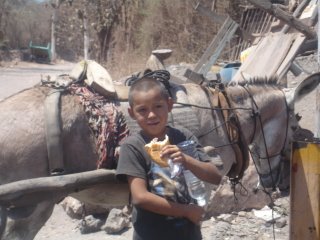The "dump tour" Mazatlán México


On Tuesday the five of us, Jaime, daughter Kati, grandson Dominique age 12, granddaughter Olivia age 4, and I as well as 20 other people of various ages, including several adolescents and young adults went to the Vineyard (a non-denominational church) early in the morning to make sandwiches to take to the people who work and live on the fringes of the one city dump that services the city of Mazatlán. The whole process of making and packaging the sandwiches and then adding oranges and water is assembly-line perfect. Energetic volunteers oversaw the work, and even Olivia assisted by placing cheese atop the ham, which others placed in large buns that had previously been cut by other worker bees. You get the picture.
Able bodied men and young boys loaded the food on a rickety bus and we all piled in. Before arriving at the dump, we visited several extremely poor colonials (neighborhoods) and toured the extremely basic churches/community centers to see what the Mexicans are being taught to do for themselves. Most fascinating was one center that makes and sells rudimentary water filter systems. Our last stop before the dump was a school for pre-school ninos. Again, very basic and rudimentary according to our standards. This country needs far more, of course.
The dump tour itself should be a mandatory visit for all tourists. It is difficult to describe the living conditions of the people in the shacks surrounding the dump. When the bus pulled into the outer fringes of the dump, men and a few women flocked to the bus. People of all ages interrupted their work to get the food with aqua being especially appreciated, sometimes preferred. Before we arrived the tour director explained that recycycling goes through several stages, beginning with the maids at the resorts going through the garbage to collect aluminum cans for which they can earn the most money, and finally the garbage collectors who take their share before arriving at the dump. The men and women rifling through the mounds of what is left look primarily for cardboard boxes and any kind of material that can be sold. Some carried the boxes on their backs, others loaded them on a few rusty trucks, and others loaded them on donkey-pulled carts. On the way out, we stopped in an area where children ran to meet the bus to get their special bags of food. A blind woman led by a friend is a regular visitor, energetic ninos cavorted spiritedly around the bus, and one woman arrived with what looked like a newborn child, wrapped carefully in a clean yellow bunting. Several others and I walked up a narrow dirt path with food for the ancient abuela, a routine. Her hovel is exactly that--no human being should have to live like that.
Surprisingly there was no proselytizing on the tour nor was their a request for money, just a prayer before we boarded the bus and an explanation of the work done by the members of the church IF we wanted to contribute funds now or in the future. Quite amazing. The trips to the dump are reduced to only two a week after the tourist season ends since much of the volunteer work for that particular project is assisted by people like those on this trip. I'm sure that I am over-simplifying. The people who stay here year round and who continue the charitable services are the ones to be admired and applauded.
The only disquieting and ironic note was that before taking our leave of one another, we all shared information on where to go for the best restaurants in Mazatlán.
I wonder how much effect this has on impressionable minds, like Dominique's and Olivia's, who was a real trouper on the bus and helped in all of the various stages. Her shyness surfaced only when greeted by children her own age. I'm convinced that daughter Kati's profession as a social worker is a result of her high school trip to Costa Rica with Amigos de las Americas when as a 16-yr-old she lived with a family for six weeks, doing volunteer dental hygiene with ninos in villages close to San Jose.
Enough for today.

1 Comments:
I'm enjoying your descriptions, Kate, and living vicariously through your Mexico-with-child's-eyes scenes. What a vacation you're having!
Inspired by your blog, I purchased a 25-CD-ROM Spanish language set at Costco for what seemed to me to be reasonable. IF I get to work with these Hispanic clients and the community service agency's bilingual staff as my master's degree project (which seems likely), knowing at least some Spanish will be helpful.
I can still read a French newspaper...my print abilities are far greater than my listening or oral or comprehension ones...but not Spanish. YET. By the end of the summer, will you write me a short note in elementary Spanish to see if I can understand it?
More in a regular e-mail. Then back to bed. Mike and I saw Memoirs of a Geisha last night--a different, and fascinating, even though fictionalized, culture...
jan on 4/7/06
Post a Comment
<< Home